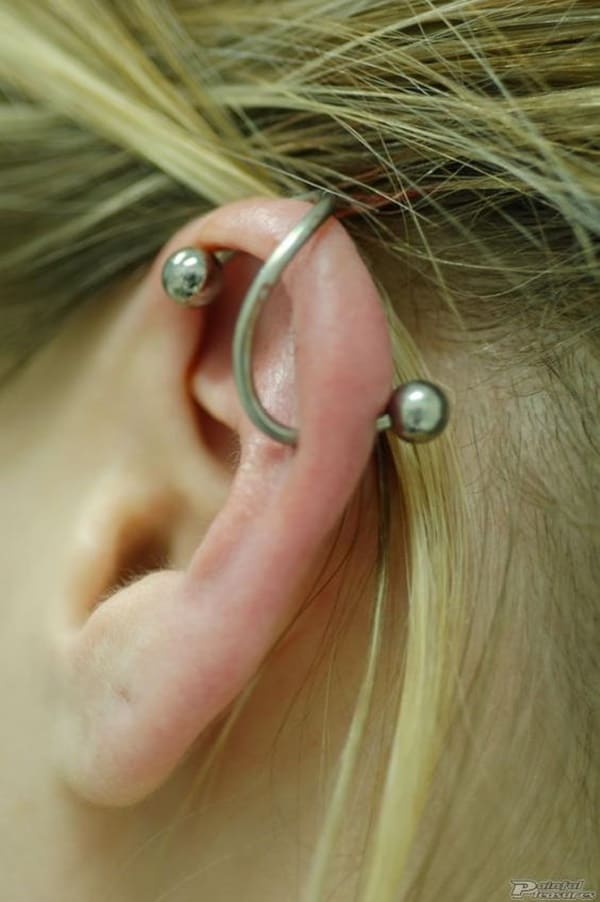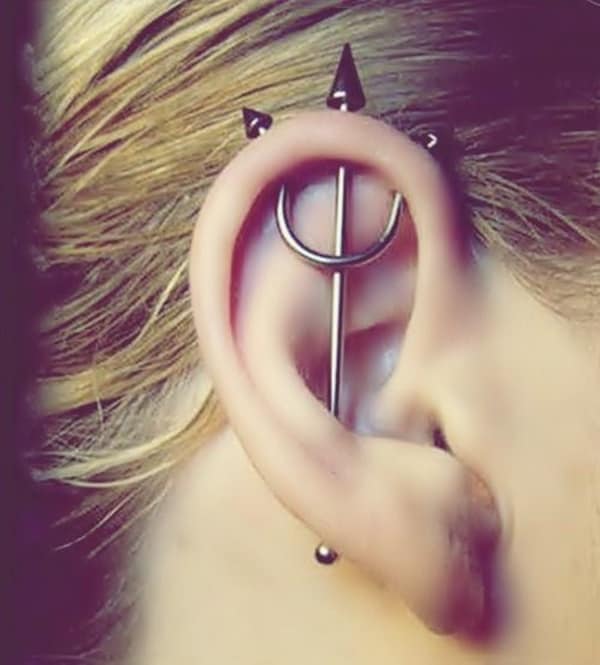Industrial piercings have become a popular form of body art, but many people are unsure about when they can change their jewelry after getting pierced. If you're one of them, you're not alone. Understanding the proper timeline for changing your industrial piercing is crucial to ensure proper healing and avoid complications.
Body modifications like industrial piercings require careful attention and maintenance. This article will guide you through everything you need to know about industrial piercings, including the healing process, when it's safe to change your jewelry, and tips for maintaining your piercing.
Whether you're a newcomer to the world of piercings or an experienced enthusiast, this guide will provide you with the information you need to make informed decisions about your industrial piercing. Let's dive in!
Read also:Priyanka Chopra Dress A Comprehensive Guide To Her Iconic Fashion Choices
Table of Contents
- Understanding the Industrial Piercing Healing Process
- When Can You Change Industrial Piercing?
- Types of Jewelry Suitable for Industrial Piercings
- Care Tips for Industrial Piercings
- Common Risks and Complications
- Signs of Proper Healing
- Frequently Asked Questions
- Expert Advice on Changing Industrial Piercings
- Statistics on Piercing Trends
- Conclusion
Understanding the Industrial Piercing Healing Process
Before discussing when you can change your industrial piercing, it's important to understand the healing process. Industrial piercings involve two puncture points connected by a single piece of jewelry, making them more complex than other types of piercings.
The initial healing phase typically lasts 6-8 weeks, during which the skin begins to form new tissue around the jewelry. However, the full healing process can take up to 6 months or longer, depending on factors such as aftercare, individual healing rates, and the type of jewelry used.
During this time, it's essential to avoid touching or rotating the jewelry unnecessarily, as this can delay healing and increase the risk of infection. Proper aftercare is key to ensuring a smooth healing process.
Initial Healing Phase
In the first few weeks after getting pierced, your industrial piercing will be highly sensitive. You may experience redness, swelling, and minor discomfort, which are normal signs of healing. However, if these symptoms persist or worsen, it's important to consult a professional piercer or healthcare provider.
Long-Term Healing Phase
As the initial healing phase progresses, the piercing will gradually become less sensitive. However, it's crucial to continue following proper aftercare practices until the piercing is fully healed. This includes cleaning the area twice daily with a saline solution and avoiding exposure to irritants such as chlorine or harsh chemicals.
When Can You Change Industrial Piercing?
One of the most common questions people have about industrial piercings is when they can change their jewelry. Generally, it's recommended to wait at least 6-8 weeks before making any changes, but this timeline can vary depending on individual healing rates.
Read also:Light Purple Nails Short The Ultimate Guide To Elevate Your Nail Art
It's important to note that even after the initial healing phase, the piercing may still be fragile. If you're unsure whether it's safe to change your jewelry, consult your piercer or healthcare provider for guidance.
Timing Guidelines for Changing Jewelry
- Wait at least 6-8 weeks after getting pierced before changing jewelry.
- Ensure the piercing is fully healed before making any changes.
- Consult your piercer or healthcare provider if you're unsure about the healing status.
Types of Jewelry Suitable for Industrial Piercings
Choosing the right type of jewelry is crucial for ensuring a safe and comfortable piercing experience. When selecting jewelry for your industrial piercing, consider factors such as material, size, and style.
Popular materials for industrial piercings include surgical steel, titanium, and gold, as these are less likely to cause allergic reactions. The size and style of the jewelry should also be chosen based on the structure of your ear and personal preference.
Material Options
Here are some of the most popular materials for industrial piercings:
- Surgical Steel: Durable and hypoallergenic.
- Titanium: Lightweight and resistant to corrosion.
- Gold: Elegant and less likely to cause irritation.
Style Options
When it comes to style, you have several options to choose from:
- Straight Barbells: A classic choice for industrial piercings.
- Captive Bead Rings: Provide a seamless look and are easy to adjust.
- Curved Barbells: Offer a more natural curve for the piercing.
Care Tips for Industrial Piercings
Proper aftercare is essential for ensuring a successful healing process and preventing complications. Here are some tips to help you care for your industrial piercing:
- Clean the piercing twice daily with a saline solution.
- Avoid touching the piercing with unwashed hands.
- Protect the piercing during sleep by using a clean pillowcase.
- Stay away from irritants such as chlorine, alcohol, and makeup.
Avoiding Irritation
To minimize the risk of irritation, it's important to be mindful of your surroundings and daily habits. Avoid wearing tight hats or headbands that could rub against the piercing, and keep your hair clean and free of product buildup.
Common Risks and Complications
While industrial piercings are generally safe when done by a professional, there are some risks and complications to be aware of. These include infections, allergic reactions, and migration or rejection of the piercing.
If you notice any signs of infection, such as excessive redness, swelling, or pus, seek medical attention immediately. Similarly, if you experience persistent pain or discomfort, consult your piercer or healthcare provider for advice.
Preventing Complications
Here are some tips for preventing complications:
- Choose a reputable piercer with proper certifications.
- Follow aftercare instructions carefully.
- Monitor the piercing for signs of infection or rejection.
Signs of Proper Healing
Knowing the signs of proper healing can help you determine when it's safe to change your industrial piercing. Some common signs include:
- Reduced redness and swelling.
- No discharge or minimal clear discharge.
- Decreased sensitivity and discomfort.
If your piercing exhibits these signs, it may be ready for a jewelry change. However, always err on the side of caution and consult a professional if you're unsure.
Monitoring the Healing Process
Regularly inspect your piercing for signs of healing or complications. Keep a journal of your progress, noting any changes in appearance or sensation. This can help you identify potential issues early and take appropriate action.
Frequently Asked Questions
Q1: Can I change my industrial piercing sooner than 6 weeks?
A1: It's generally not recommended to change your industrial piercing before 6 weeks, as the piercing may still be fragile and prone to complications. Always consult your piercer or healthcare provider for personalized advice.
Q2: What should I do if my industrial piercing becomes infected?
A2: If you suspect an infection, seek medical attention immediately. Your healthcare provider may prescribe antibiotics or recommend other treatments to address the issue.
Q3: Can I swim with a new industrial piercing?
A3: It's best to avoid swimming in pools, lakes, or oceans until your piercing is fully healed. Chlorine and other chemicals can irritate the piercing and delay healing.
Expert Advice on Changing Industrial Piercings
According to renowned piercer and body modification expert, Jane Doe, "Changing your industrial piercing too soon can lead to complications such as infection or migration. It's important to prioritize proper healing and consult a professional before making any changes."
Experts emphasize the importance of patience and proper aftercare in ensuring a successful piercing experience. By following their advice, you can minimize risks and enjoy your industrial piercing for years to come.
Professional Guidance
When in doubt, always seek guidance from a licensed piercer or healthcare provider. They can provide personalized advice based on your specific needs and circumstances.
Statistics on Piercing Trends
According to a recent study published in the Journal of Body Modification, industrial piercings have seen a significant increase in popularity over the past decade. In 2022 alone, approximately 15% of all new piercings performed were industrial piercings, highlighting their growing appeal among body modification enthusiasts.
These statistics underscore the importance of understanding proper aftercare and jewelry choices to ensure a positive piercing experience.
Conclusion
In conclusion, knowing when you can change your industrial piercing is crucial for ensuring proper healing and avoiding complications. By following the guidelines outlined in this article, you can make informed decisions about your piercing and enjoy its beauty and uniqueness.
We encourage you to share your thoughts and experiences in the comments below. If you found this article helpful, consider sharing it with others who may benefit from the information. For more tips and advice on body modifications, explore our other articles on the website.


